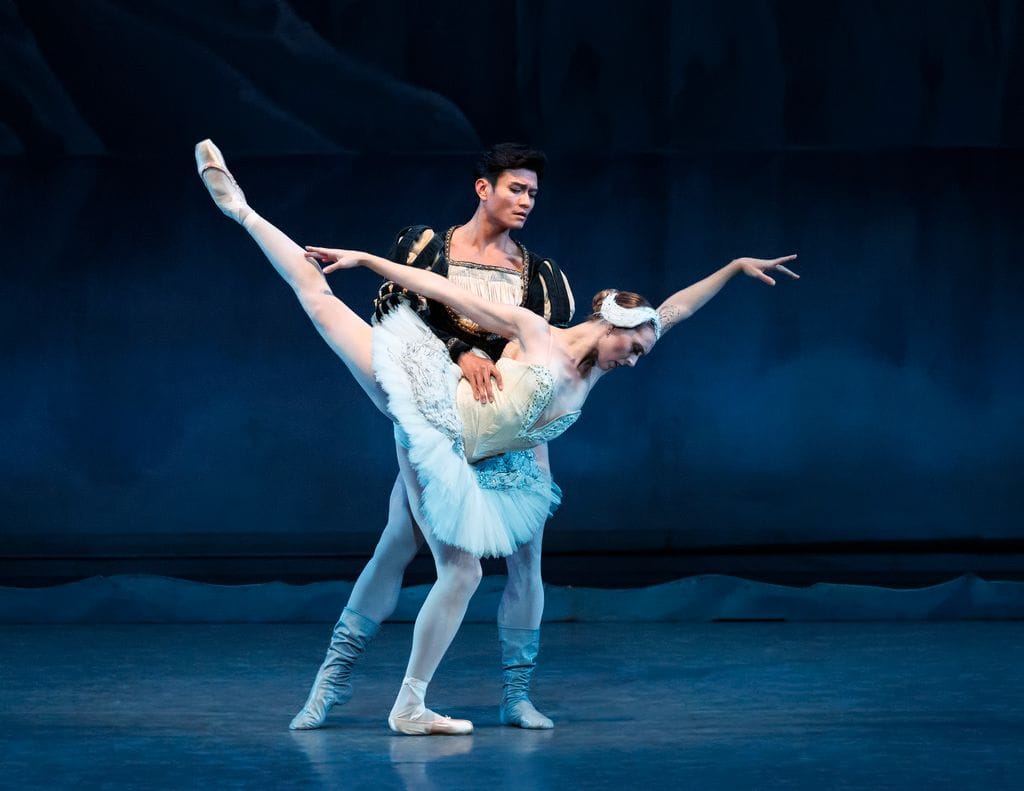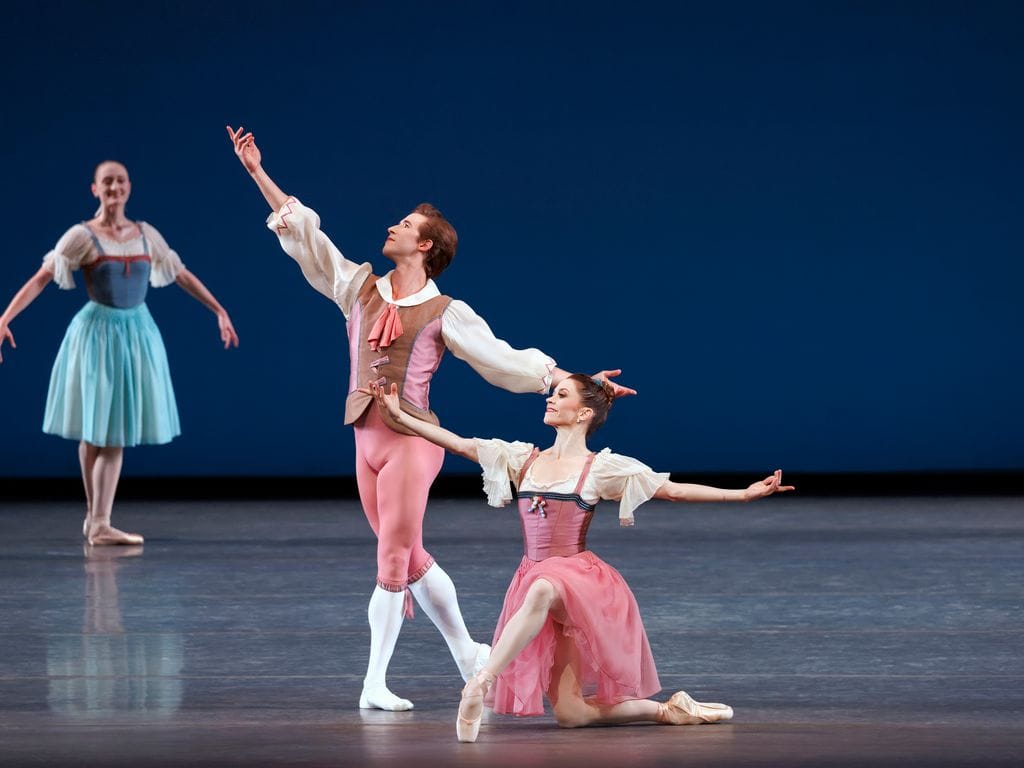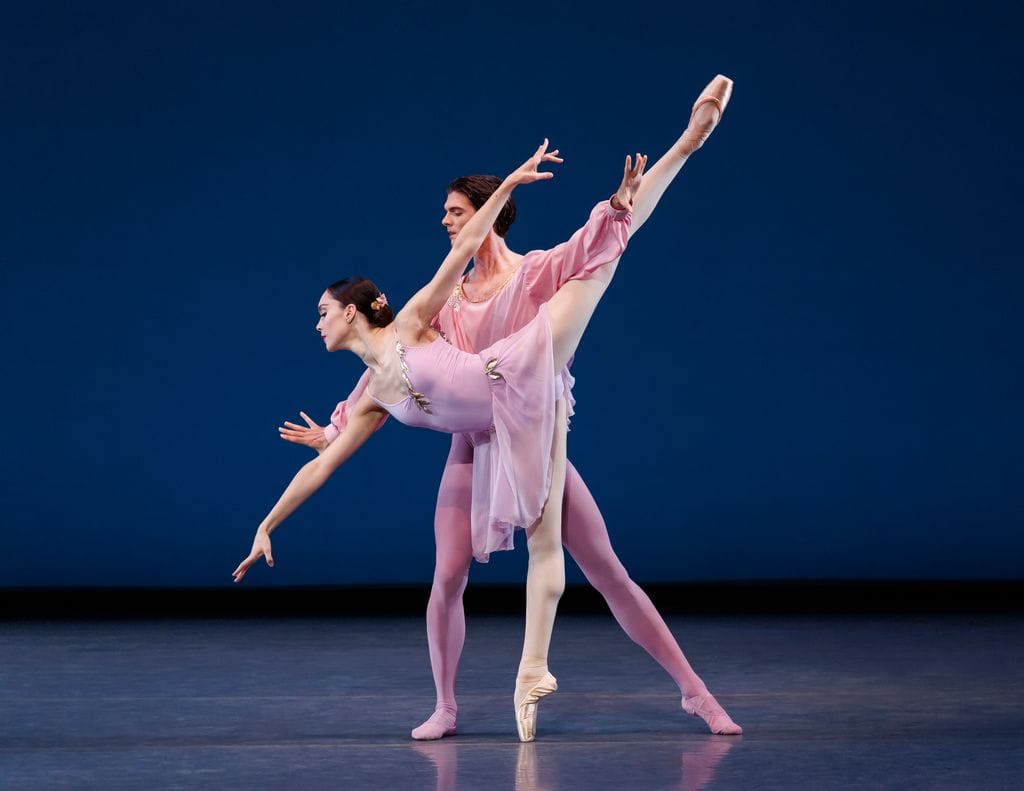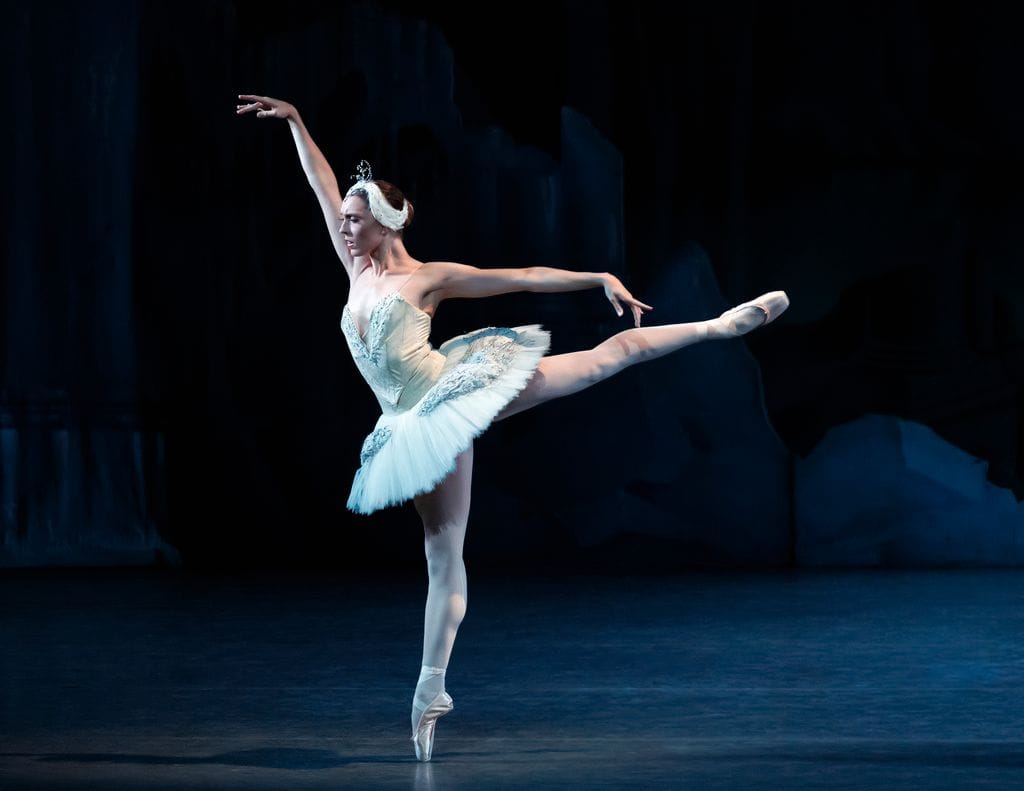Love, Found and Lost

“Donizetti Variations”, “Ballade”, “Swan Lake”
New York City Ballet
David H. Koch Theater
Lincoln Center
New York, New York
September 16, 2025
New York City Ballet opened its Fall season with an all Balanchine evening, showing three variations of love, both lost and found, all set to nineteenth-century music. There were two standards, “Donizetti Variations” and “Swan Lake”, and one rare revival, the 1980 “Ballade”, set to “Ballade for Piano and Orchestra” by Gabriel Fauré. “Donizetti Variations” has a happy, cheerful couple, accompanied by peasanty corps who could have wandered over from any number of 19th century ballets. “Swan Lake”, Balanchine’s one-act meditation on the iconic warhorse, does not end happily, as the Romantic curse of a mortal man in love with an unattainable magical creature strikes again. “Ballade”, at least in this performance, seemed to recreate that same idea, as the couple, surrounded by a purple-clad corps looking like the spirits of sea anemones, float off sadly in different directions.

Balanchine set the cheerful, Bournonville-inspired “Donizetti Variations” to ballet music from the opera Dom Sébastien, a five-act work set in the 16th century, full of battles and deaths, ending with the loss of Portuguese freedom; the bouncy, melodic ballet music must have been a pleasant break for the opera’s audiences. Balanchine’s ballet is a very pleasant break, a garland of steps for the couple (Megan Fairchild and Joseph Gordon) and the energetic corps. Fairchild, who is retiring next May, began her farewell season with a flourish, dancing the frilly little steps (so many hops on point and hip swivels) with a lyrical generosity and a flirty delicacy, along with some strong Italian pas de chats. Her dancing was strong and clear, and she gave the anonymous heroine a cheerful and open nature, with a natural sweetness utterly devoid of simpering or coyness.
Gordon’s dancing, too, was impressive, with sharp, clear turns, crisp entrechats, and strong partnering—there are a lot of off-balance poses and tricky catches which he made look easy. His three male companions, Kennard Hanson, Charlie Klesa, and McKenzie Bernardino Soares, were especially striking, soaring through the fast, low jumps, and snapping their fingers with a fine Spanish flair. The speed of the music, though, seemed to throw some of the corps women, who substituted a go-for-broke enthusiasm for style and there were a few near-collisions.

There were no collisions and plenty of style in “Ballade”, danced by Mira Nadon and Peter Walker in their joint debuts. The haunting music (Hanna Hyunjung Kim was the pianist) seemed to summon Nadon from some mysterious place as she floated through the ever-changing shapes that her long legs and elegant arms made. Without “acting”, she seemed to be looking for someone; she is a dancer who makes the stage disappear and lets her inner thoughts glow. When the someone (Walker) entered, Nadon seemed to vanish and reappear; she was a sylph who didn’t need a story to create a mystery.
Though Walker did have some issues with his solo, he was a dignified and able partner, but he missed some of the urgency that ballet’s Romantic mortals felt when searching for their mysterious and unattainable soulmates. The ballet is somewhat unbalanced, as it opens with a long, episodic pas de deux with the female corps entering in the middle, apparently to fill out the music. But it has the coherence of a half-forgotten dream and a magical, unforgettable heroine in Nadon.
Balanchine’s “Swan Lake”, too, lacks coherence, and what is worse, lacks magic, though there is some poetry left in the remaining bits of Ivanov. Alain Vaes’ 1986 redesign, which set the lake in an Arctic glacier and dressed the swans in black (only Odette wears white), certainly doesn’t help since their black dresses makes the corps look like Von Rotbart’s assistants rather than his helpless captives. At the end, though, Balanchine does have the corps do their best to separate the couple, so maybe they were working for Von Rotbart all along, but then why would Odette desperately rush out earlier to protect them from the hunters? And why is Siegfried so earnestly looking for Odette among the corps when she is clearly not one of the black swans? The original “Swan Lake” may have been a fairy tale, but it certainly had an emotional logic which is missing from this version.
Balanchine seemed to be half telling the story and half ignoring it. There are real mechanical swans, proper medieval huntsman, and an evil villain, but nothing really connects. The mime has been dropped, but not the narrative, so Odette does some vaguely swan-like motions to the mime music, but then dramatically protects Von Rotbart from Siegfried; since the audience is never told that if Von Rotbart is shot, she and her fellow captives will remain swans forever, she seems like she is suffering from Stockholm Syndrome. Balanchine could certainly choreograph abstract versions of “Swan Lake”—“Diamonds” and the second movement of “Symphony in C” for example. There are echos of Aurora in “Theme and Variations”, but “Theme” doesn’t have or need a Carabosse and a curse; a “Swan Lake” with a Von Rotbart needs a story.
Isabella LaFreniere in her New York debut and Chun Wai Chan in his debut did seem to be telling a story, though it wasn’t always the same one. Chan was a very princely Siegfried, dismissing the hunters with a natural superiority (he has danced Siegfried in other full-length productions). He is a bit too short for LaFreniere, and though he was a devoted and secure partner, she almost overwhelmed him. His solo, too, was a bit shaky, as he had an uncharacteristic slip. He did convey a nuanced understanding of Siegfried’s tragedy, and was able to wring as much emotion as possible out of the rather dry ending.

LaFreniere was an imperial, statuesque Odette, wary rather than frightened. Her dancing was stately and unmannered, without extraneous fluttering or exaggerated shapes. She flowed through the choreography, letting the beauty tell its own story. The White Swan pas de deux is almost entirely Ivanov, and she, supported by Chan, gave it an old fashioned glamor, with smooth, flowing, undistorted arabesques and luxurious backbends. Their adagio had an elegiac poetry, until Balanchine’s chipper little coda broke the spell.
Though Balanchine used the music traditionally danced by the two big swans for Siegfried’s solo, he did give the two swans (Meaghan Dutton O’Hara and Mary Thomas MacKinnon, both debuts) his most interesting choreography, as they led cohorts of swans in intricately musical geometric formations. Dutton O’Hara led the Pas de Neuf with a particularly elegiac mournfulness, lingering slightly in her positions, as if her arms were sighing. It was a gentle reminder of “Swan Lake’s” magic.
copyright © 2025 by Mary Cargill



